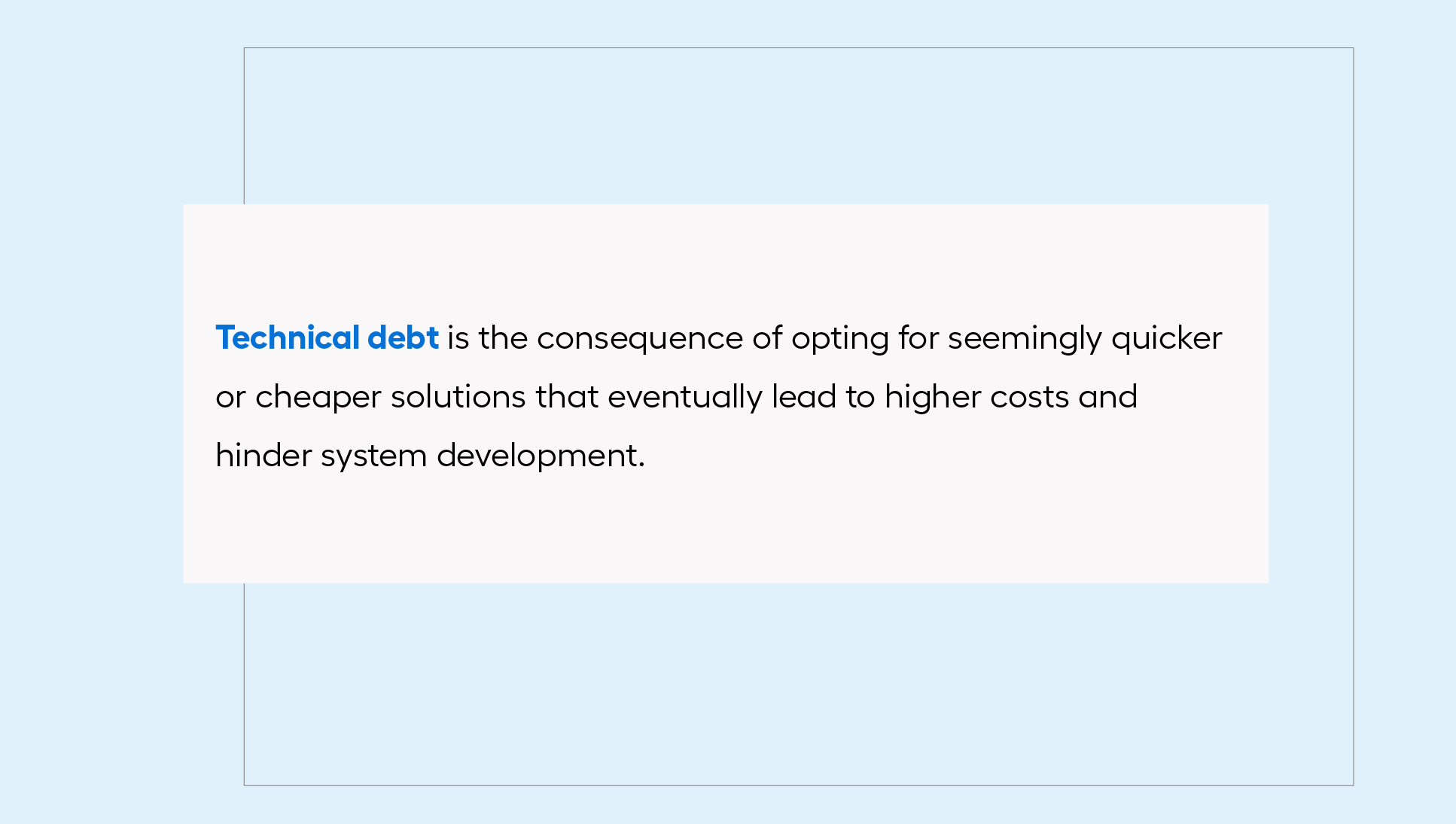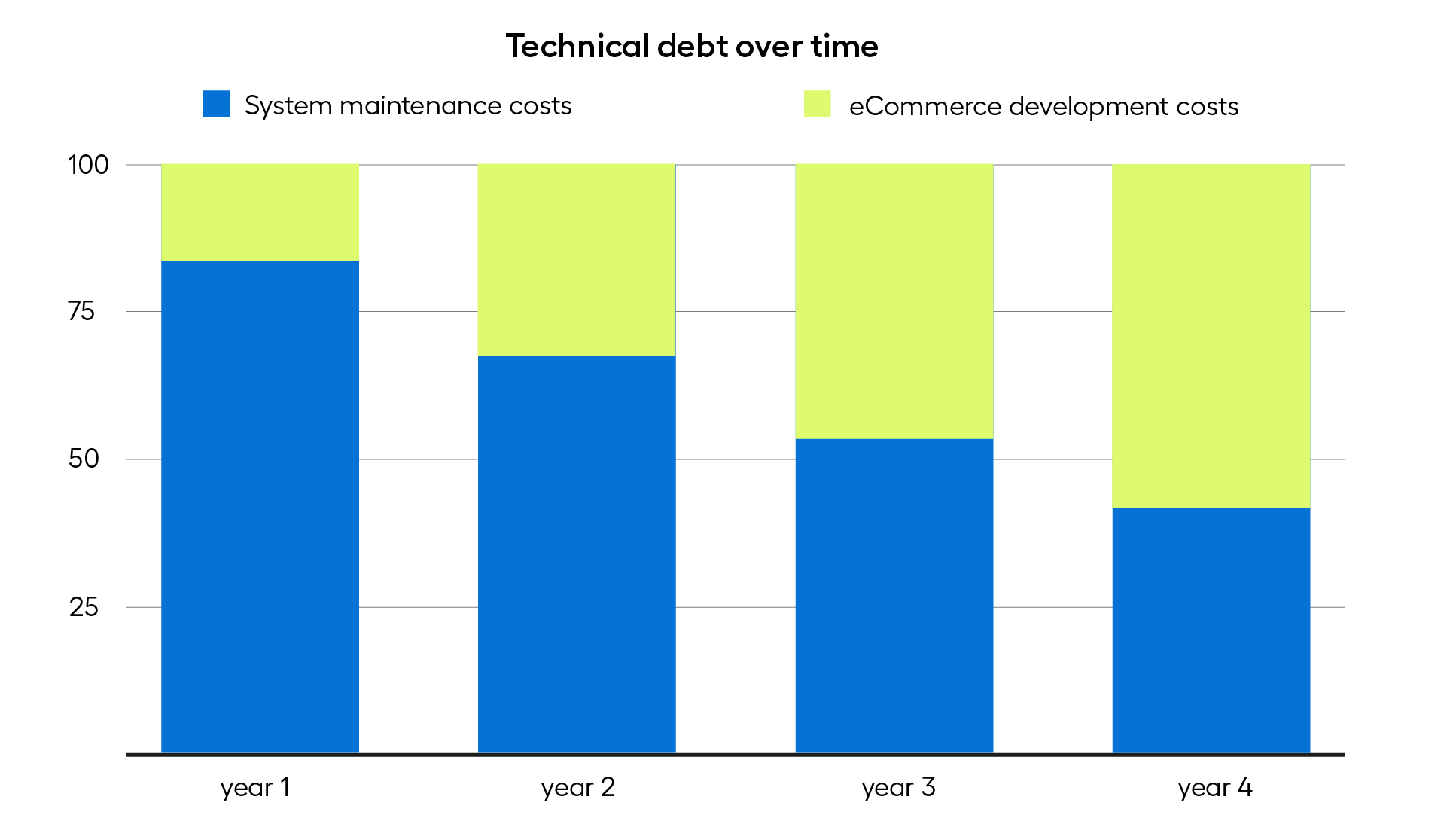Table of contents:
- What is technical debt?
- How to calculate technical debt?
- Types of technical debt
- What can cause technical debt?
- A trap for your online store - the negative consequences of technical debt
- How to avoid technical debt in eCommerce?
- Is technical debt always bad?
- How to effectively manage technical debt in your online store?
Stripe estimates that combating technical debt costs the global economy up to $3 trillion - funds that could otherwise be invested in innovation and business growth (according to the "The Developer Coefficient" report). These are massive losses for businesses, which can be significantly reduced through conscious technology management. Learn what technical debt is, what causes it, how to avoid it (and whether it's always something to fear). Check out this article, where we take a closer look at this concept!
What is technical debt?
What comes to mind when you hear the term "technical debt"? The word "debt" typically brings up associations with financial obligations that need to be repaid, often with additional interest. A similar concept applies to technical debt - it refers to technological decisions that may seem advantageous at first but result in additional costs and challenges in the long run.
Simply put,

How to calculate technical debt?
Calculating the exact value of technical debt isn’t straightforward—there’s no universal formula to clearly define how much a company will pay for
past technology decisions. Technical debt encompasses not only direct costs, such as system maintenance or bug fixes, but also hidden expenses:
business limitations, lost market opportunities, and delays in implementing new features.
A company opts for Solution X, which costs €10,000 to implement—much cheaper than Solution Y, priced at €50,000. However, over three years, the costs of modifications, repairs, and adjustments for Solution X could amount to €30,000, bringing the total to €40,000. Additionally, the limitations of Solution X might hinder the store’s growth and reduce conversion rates, resulting in lost revenue opportunities. On the other hand, Solution Y, though more expensive upfront, incurs lower maintenance costs (e.g., €5,000 annually), enabling the company to focus on development and adapt the store to evolving customer needs. Over time, the more expensive solution proves to be both more cost-effective and more flexible.

Types of technical debt
Technical debt can arise either intentionally or unintentionally. Sometimes, companies knowingly take on the risk to gain short-term benefits (e.g., quickly implementing a new solution). In other cases, it’s the result of time pressure, insufficient knowledge, or unforeseen circumstances. Technical debt can be divided into four main categories:
- deliberate and reckless - debt taken on consciously but without thoroughly analyzing the risks, such as choosing a quick-to-implement but inflexible solution under time pressure.
- deliberate but thoughtful - a well-considered decision where short-term benefits (e.g., faster implementation, competitive advantage) outweigh future costs. In this case, the company plans for the eventual "repayment" of the technical debt.
- unintentional and reckless - arises from a lack of knowledge, experience, or oversight during the design process, such as using outdated technologies that limit further development from the outset.
- unintentional but thoughtful - results from unforeseen circumstances despite prior due diligence. An example might be implementing a technology that is soon replaced by a more efficient and modern solution.
Each of these categories requires a different approach and carries varying consequences. However, they all share a common reality -
What can cause technical debt?
Technical debt often arises from the need to balance business goals with constraints like time, budget, or resources. While decisions made at the moment may seem rational, their long-term consequences often become apparent only later. It’s similar to taking out a loan on unfavorable terms, where the accumulating interest creates mounting challenges. What situations might signal the onset of technical debt?
- The need for rapid implementation (time pressure)
- Limited budget and the desire to minimize costs
- Poor translation of business needs into IT solutions
- Neglecting proper documentation
- Low-quality code
- Lack of testing or an inadequate testing environment
A trap for your online store - the negative consequences of technical debt
When technical debt begins consuming more and more resources, its effects extend far beyond financial issues - it impacts the entire operation of your store, limiting efficiency and stifling growth. The most significant consequences of technical debt include:
- Increased vulnerability to errors and downtime - solutions that don’t meet current IT standards are more prone to bugs and failures. Frequent disruptions in store functionality may require additional work from developers while discouraging customers from returning, leading to decreased sales and loss of trust.
- Lack of scalability and flexibility - a platform burdened with technical debt isn’t equipped to handle growing business demands. Adding new features, accommodating more users, or expanding into new markets becomes time-consuming and expensive, slowing the company's growth.
- Decreased software performance - technical debt often results in slower systems and less efficient processes, such as order fulfillment or product searches. Slow store performance can frustrate customers and lead to abandoned shopping carts.
- Difficulty integrating with external systems - technical debt can make it challenging—or even impossible—to integrate new external systems with your eCommerce platform (e.g., payment gateways, warehouse management systems, or analytics tools). Each integration requires additional time, effort, and costs.
- Increased security risks - systems weighed down by technical debt are more vulnerable to security breaches. In the event of customer data leaks or compromised payment systems, the company could face not only financial losses in the form of regulatory fines but also significant reputational damage - far harder to recover from than material losses.
One of the best ways to ensure high quality code is to work with a reliable software house. An experienced technology partner will not only provide robust solutions, but will also ensure compliance with modern standards and help you choose technologies that fit your long-term business goals.
How to avoid technical debt in eCommerce?
Every online store that relies on technology inevitably faces some degree of technical debt. While it’s impossible to eliminate it entirely, there are effective ways to minimize its impact on business growth. Here are the key strategies:
- Maintain high quality standards - well-written, clean, and readable code, along with adherence to best programming practices, is the foundation for avoiding escalating issues. It’s also worth investing in detailed technical documentation, which makes future system development and maintenance much easier.
- Regularly Monitor Platform Performance - technical audits and systematic code reviews help identify errors and issues early, preventing them from evolving into major obstacles.
- Use tools to analyze technical debt - tools like SonarQube, SonarGraph, or Klocwork enable real-time monitoring of code and highlight areas that could cause problems. While they may not detect large-scale issues involving multiple parts of the system, they provide valuable insights to prioritize fixes.
- Prioritize alignment with business needs - translating business strategy into IT systems is a crucial step. An eCommerce platform should support the company’s goals, not become a barrier. Before implementation, conduct a thorough analysis of business needs and plan solutions with a long-term perspective in mind.
One of the best ways to ensure high-quality code is by partnering with a trusted software house. An experienced technology partner will not only deliver robust solutions but also ensure compliance with modern standards and help choose technologies aligned with long-term business objectives.
Is technical debt always bad?
Technical debt doesn’t always have to be synonymous with a “necessary evil.” When approached thoughtfully and strategically, it can become a tool to support business growth. A good example is startups that create a simplified version of their product to quickly enter the market and test their idea. This approach allows them to attract initial customers, gather feedback, and prepare for further development, with the assumption that the resources to repay the technical debt will come from growing sales or investor support.
In such cases, technical debt can stimulate business growth - provided there’s a clear plan for eliminating it from the very beginning. However, failing to take corrective actions in a timely manner will likely turn the debt into a significant burden that limits flexibility and hampers business development.
How to effectively manage technical debt in your online store?
Technical debt isn’t just about poorly written code or the wrong technology; it also stems from project management oversights, such as missing documentation or insufficient testing. Its effects can be costly - lowering system performance, limiting scalability, increasing security risks, and, most importantly, discouraging customers from making purchases.
If you want to reduce technical debt in your online store or minimize the risk of it arising, get in touch with us! The specialists at Advox will help you analyze challenges, implement necessary changes, and plan for stable technological development that supports your business at every stage. Need help with this? Contact us today!



